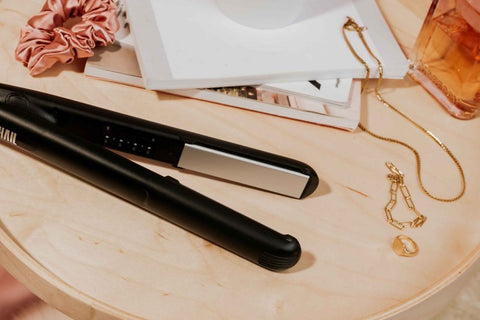Heated hair tools are brilliant for creating the hairstyles we love, from voluminous blowouts to bouncy curls and sleek, straight styles. However, before using heat, it’s important to protect your hair to minimize the risk of damage.
But fear not, maintaining healthy hair doesn’t mean you have to put away your heated hair tools for good (and what a sad day that would be!). Here, we share our best tips for how to protect your hair from heat and how to identify heat damaged hair, so you can use your heated hair tools with confidence.
How to identify heat damaged hair?
Firstly, knowing how to identify heat damaged hair is essential. Hair gets damaged when the protective outer layer of your hair (known as the cuticle) is broken, leaving your hair unhealthy and weak. Below are the top five indicators of heat damaged hair:
- Split ends
- Overly dry hair
- Easily knotting hair
- Fizziness and flyways
- Change in texture (natural curls will not bounce back, and straight hair will feel rough)
Do you recognize any of these indicators in your hair? If so, keep reading to find out how to revitalize your damaged locks!
8 Tips on How to Protect your Hair from Heat
Tip 1 – Only Use the Best Heated Hair Tools
This is a no-brainer! Investing in professional and quality heated hair tools can help to minimize heat damage, with proper use. The Hail Your Hair Straightener comes automatically set to 180 degrees Celsius, which is the optimum temperature for heat styling. Importantly, it also comes with variable temperature controls, so you can have greater control of the amount of heat you’re applying to your hair. We know that everybody’s hair is different and not everybody is after the exact same look, so using a straightener that allows you to use less heat when desired is key.
Tip 2 – Use a Low Heat Setting
There’s a tendency to set your straighteners or curling iron to the hottest temperature possible. However, this isn’t always necessary to achieve a flawless style, and a hotter temperature is more likely to cause damage.
For fine hair, it’s best to set your heated tool at the lowest temperature setting . For thicker hair, increase the heat setting incrementally to find what works best for you, but try and stay below 300°C for the best heat damage precaution.
Tip 3 – Heat Protection, Heat Protection, Heat Protection!
Never apply heat to your hair without applying a heat protectant. Apply a protective spray or serum on damp hair before using your hair dryer. Then, reapply to dry hair before styling with a heated tool.
Extra tip: We recommend sectioning your hair and applying protectant evenly to each section. This way, you won’t neglect the underlayer of hair!
Tip 4 – Great Hair Begins in the Shower (Conditioner & Hair Masks)
Heat damaged hair can leave your hair feeling dry and frizzy. We recommend using shea butter, argan oil and coconut-based conditioners and hair masks. These products will help to seal in moisture and restore a healthy shine for straight hair or bounce for curly hair.
Tip 5 – Wet Hair? Do Not Apply Heat!
Never blow dry excessively wet hair. Instead, use a microfiber towel or leave time for your hair to air dry before applying heated tools. This means your hair will be under the heat for less time, offering better protection.
Extra Tip: For curly hair, try using a t-shirt instead of a towel and plop your hair to enhance your curls naturally!
Tip 7 – Consider How Long your Hair is Under the Heat
Have you ever applied heat over and over again to that one section of hair that just isn’t cooperating? We’ve all been there! However , to minimize heat damage, you should avoid re-styling sections you’ve already applied heat to. Instead, we recommend frequently moving your heated hair tools throughout your hair.
Extra tip: For straight hair, try experimenting with either blow drying or straightening for that sleek and shiny look, rather than using both heated hair tools.
Tip 6 – Treat your Hair to a Satin Pillowcase
A good night’s sleep, a satin pillowcase and healthy hair – what more could we ask for? Swapping your current pillowcase for a satin one has many benefits for your hair, including: less frizz, keeping your hair hydrated (remember – heat damaged hair is often dry), and prolonging your style achieved through heated tools.
Tip 8 – Clean Heated Hair Tools = Healthy Hair
Hair products can cause a buildup of muck on your heated hair tools. Dirty heated hair tools can cause damage to your tools and to your hair so, ensure you are cleaning your tools properly.
Quick Top Tips on How to Protect Hair from Heat
- Avoid shampooing too often as shampoo strips the hair of its natural oils.
- When you do use shampoo, focus the product on your scalp.
- Experiment with heatless hairstyles, sometimes.
- If in doubt, speak to your hairdresser for tailored tips on your hair type.
The Bottom Line on How to Protect your Hair from Heat
Our main advice on how to protect hair from heat damage is to invest in good quality heated tools, always use a heat protectant, and replenish your hair in the shower with moisturizing conditioners and hair masks.
For more hair care advice and hair styling tips, head to our blog and don’t forget to follow us on Instagram and Pinterest!
